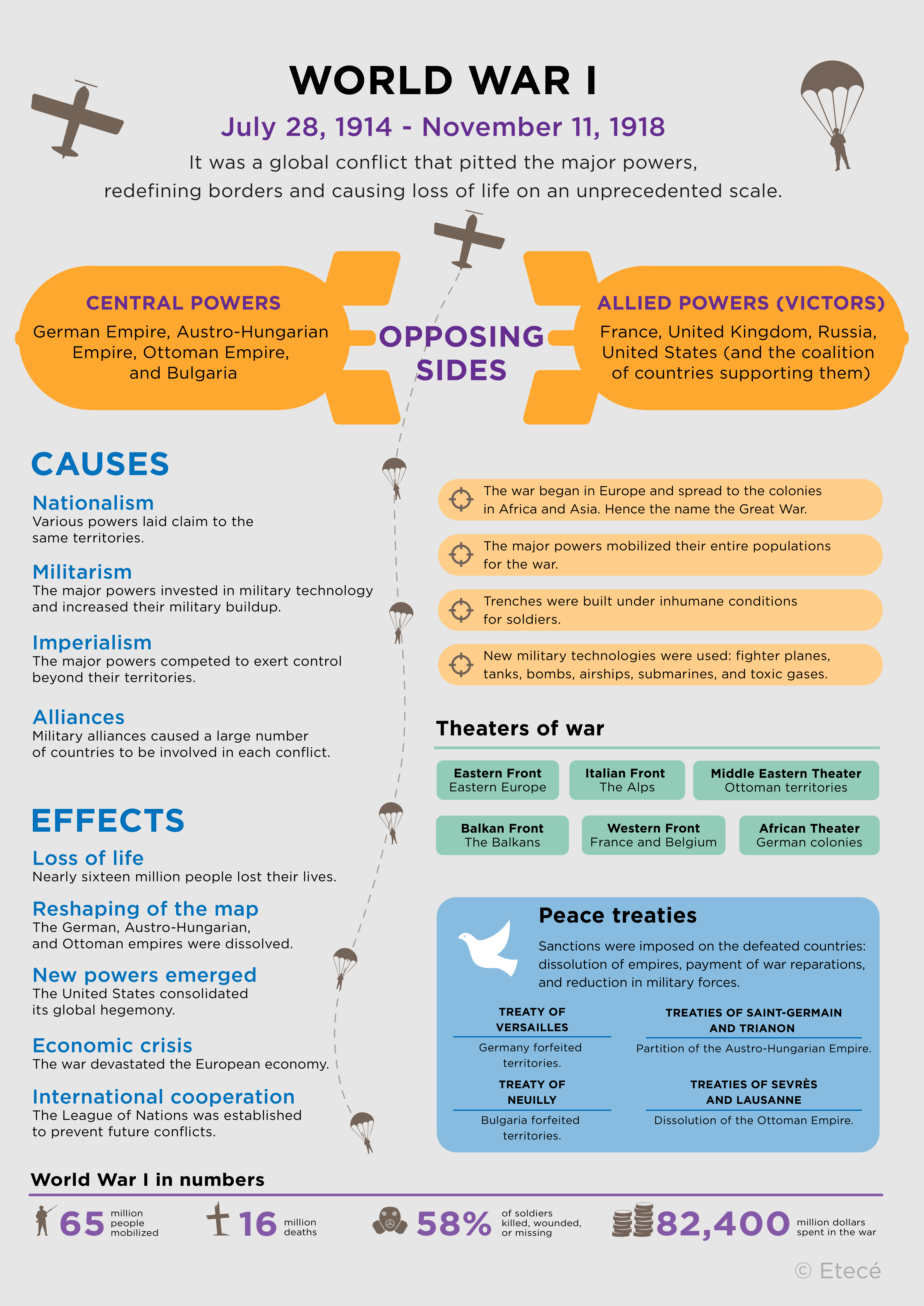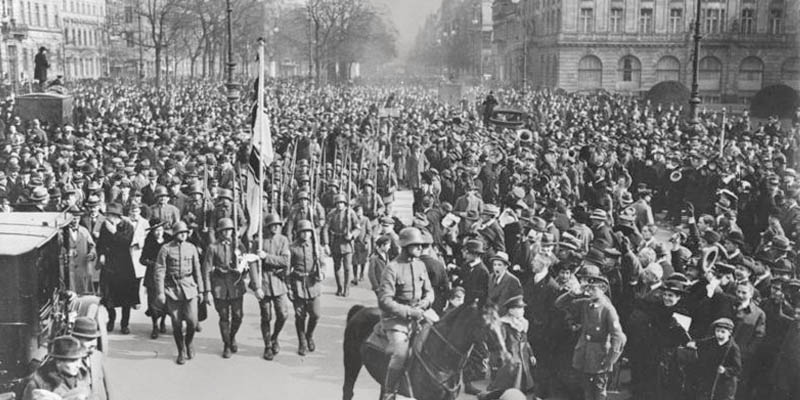We discuss the war reparations of the Treaty of Versailles, and explore their implementation and consequences.

What were the war reparations of the Treaty of Versailles?
The war reparations of the Treaty of Versailles were economic obligations imposed upon Germany by the Allies following World War I (1914-1918).
After the Allied victory (led by France, the United Kingdom, the United States and Italy) over the Central Empires (the German Empire, the Austro-Hungarian Empire, and the Ottoman Empire), a peace conference was convened in Paris in 1919, from which the governments of the defeated countries were excluded. At the conference, the creation of the League of Nations was agreed upon (at the initiative of the US government), and territorial, military and economic clauses to be imposed on the defeated countries were defined.
One of the outcomes of the Paris conference was the signing of the Treaty of Versailles with Germany (which the German government was forced to sign on June 28, 1919). The treaty made Germany responsible for the war and imposed harsh peace terms, including disarmament, territorial losses, and the obligation to pay war reparations or indemnities to the victorious countries.
The US Congress ultimately refused to sign the treaty, and the United States never joined the League of Nations. The United Kingdom, and particularly France, demanded that Germany fulfill its obligations, while the German government declared itself unable to meet such demands. This led to various conflicts in the early 1920s: an attempted coup d'état and social unrest in Germany, the occupation of the German Ruhr region by Belgian and French troops, as well as economic problems in France and, especially, in Germany.
The situation began to stabilize when a committee put forward by the United States drew up a plan in 1924 to ensure both the payment of reparations and German economic stability. Nevertheless, the signing of the Treaty of Versailles had fueled resentment among nationalist sectors in Germany against the Allied powers and the Weimar Republic (the German government), a circumstance that was seized by the National Socialist movement, which gained prominence during the years of the Great Depression.

- See also: World War I
Treaty of Versailles (1919)
The Treaty of Versailles, signed in 1919, imposed severe terms upon Germany:
- The military clauses required a drastic reduction in armaments and military forces, in addition to the establishment of demilitarized zones and areas of Allied occupation in the Rhineland (in western Germany).
- The territorial clauses resulted in the loss of extensive German territories to other countries like France, Belgium and Poland, in addition to the loss of all its colonies.
- The political clauses banned Germany from entering the League of Nations, the international organization for cooperative conflict resolution created by the signing of a pact annexed to the Treaty of Versailles.
- The economic clauses imposed on Germany the payment of indemnities (war reparations) to the Allied countries in the form of resources, machinery, and bonds or cash.
The treaty justified the sanctions imposed upon Germany by including an article accusing it of being responsible for the war. Subsequent articles stated that Germany must pay war reparations, even while acknowledging that the German economy did not have sufficient resources, and established May 1921 as the deadline for a Reparations Commission to determine the total amount to be paid by the German state.
Position of the major powers on the Treaty of Versailles
Germany

Germany accepted the Treaty of Versailles under protest. Two aspects were particularly unbearable for the German government and public opinion: the payment of war reparations as the country responsible for the conflict, and territorial losses, most notably those on the eastern border.
Germany referred to the Treaty of Versailles as the diktat (the imposition) and, from the outset, focused its objectives on securing its revision and avoiding compliance with its onerous conditions.
The paradox of the Treaty of Versailles was that it was a very harsh treaty whereby not overly strong powers (France and the United Kingdom) were attempting to impose on a country that still retained much of its economic strength (Germany). The reasons for this paradox are twofold:
- In the first place, American isolationism. The United States' refusal to sign the Treaty of Versailles and join the League of Nations left France and the United Kingdom as the sole powers responsible for constructing the European order outlined at the Paris Conference.
- In the second place, the exacerbation of Franco-British weakness. This came as a result of the disparity of ideas between the London and Paris governments.
United States
The isolationism that traditionally characterized the US government to avoid permanent alliances was what led the US Congress to reject the signing of the Treaty of Versailles and the Covenant of the League of Nations, despite the fact that it had been US President Woodrow Wilson who had championed the League's creation.
The reason for this was the US Senate needed to ratify treaties by a two-thirds majority. Wilson, a Democrat, faced a Senate with a Republican majority. In the midst of the debate, Wilson was confined to his home for three months due to a stroke, and refused to negotiate any amendments to the treaties with the Republican leader in the Senate’s Foreign Relations Committee, Henry Cabot Lodge.
Wilson's proposal was defeated in the Senate and, when Republican candidate Warren G. Harding became President of the United States in March 1921, it was definitely rejected. In August 1921, the US government signed separate peace treaties with Germany, Austria, and Hungary.
The task of overseeing the implementation of the Treaty of Versailles fell solely to France and the United Kingdom, with little assistance from Belgium and Italy, although the United States subsequently became involved in discussions over reparations, putting forward a committee that drew up the Dawes Plan in 1924.
United Kingdom and France
The United Kingdom, center of a worldwide empire at the time, sought to maintain its long-standing policy of sustaining a continental balance in Europe. The aim was to ensure that neither Germany nor France would become too powerful, thus allowing Britain to focus on growing issues posed by independence movements in Ireland, Egypt and India.
With public opinion increasingly influenced by the ideas of economist John Maynard Keynes, who believed that the implementation of the Treaty of Versailles would have negative consequences for Germany and the rest of Europe, the British government became convinced of the need to foster German prosperity as a premise for European economic progress. This position implied a conciliatory attitude towards German reluctance to pay war reparations.
The French government, on the other hand, considered that the most pressing issue was to impose measures that would weaken Germany and force it to comply with the Treaty of Versailles. This stance was driven by the American refusal to sign the Treaty of Versailles, which left France unprotected in the event of a future German attack. The demand for full payment of reparations sought not only to contribute to France's economic recovery, but also to weaken the German economy.
Implementation of the Treaty of Versailles
Reparations at the forefront of the conflict

From the beginning, Germany showed itself contrary to complying with the clauses of the Treaty of Versailles. The first conflict related to this refusal occurred in March 1920, when a failed coup attempt against the Weimar Republic in Germany was staged by ultra-nationalist politician Wolfgang Kapp. The coup was quashed within a few days.
In reaction to the coup attempt, workers in the Ruhr region (in western Germany) organized a general strike, and the German army, in order to suppress the workers' uprising, entered the demilitarized zone, an action that contravened the Treaty of Versailles. France's response was immediate: French troops occupied Frankfurt, Darmstadt, and Duisburg.
At the Spa Conference in July 1920, the Allies determined the percentage of German reparations that each state would receive. On April 27, 1921, the Reparations Commission, which had been set up by the Treaty of Versailles and was chaired by French statesman Raymond Poincaré, announced the total amount to be paid by Germany in reparations: 132 billion gold marks. Faced with Germany's indignant reaction, the Allies responded with a threat to invade the Ruhr basin.
Germany continued to fail in the payment of indemnities. For a brief period, it seemed that the French government, under Prime Minister Aristide Briand since January 1921, might reach an agreement with British Prime Minister David Lloyd George to ease the reparations payments.
However, in January 1922, as Briand and Lloyd George began a meeting in Cannes, Briand was summoned to Paris, where he was forced to resign. The President of the French Republic, Alexandre Millerand, appointed Poincaré to the position of Prime Minister. Thus, the so-called policy of treaty execution had prevailed in France: Germany must be forced to pay.
The Genoa Conference and the Treaty of Rapallo (1922)
In May 1922, a Conference was held in Genoa which, for the first time, was attended not only by the victorious Allies but also by the two great losers of the war: Germany (defeated at war) and Russia (which had signed a peace treaty with Germany following the Bolshevik revolution and had lost many territories). The aim was to address the severe economic situation and to integrate Soviet Russia into the European order.
The Genoa Conference was a failure. Its most consequential outcome was the signing of the Treaty of Rapallo between Germany and Russia, which took place on the sidelines of the conference. The two big war losers, while maintaining mutual distrust, began a period of economic and even military collaboration.
Germany sought to unsettle the Western powers and that they would thus lower their demands on the issue of reparations. Russia attempted to reinsert itself into European international politics. The Treaty of Rapallo was further deepened by a new German-Soviet treaty in 1926.
Poincaré, concerned about the potential implications of the German-Russian rapprochement, became increasingly convinced of the need for drastic decisions that would force Germany to fulfill its obligations. A new German request for a moratorium on the payment of reparations in July 1922 precipitated the French decision to occupy the Ruhr region.
Occupation of the Ruhr (1923)

On January 11, 1923, French and Belgian troops occupied the Ruhr basin, the mining and industrial heartland of Germany, intending to seize war reparations owed to them. Although the British refused to join the action, their protests were initially lukewarm.
The reaction of the German government, headed by Chancellor Wilhelm Cuno, was to declare passive resistance. Factories closed, and the government subsidized strikers. The situation precipitated the collapse of the German economy, which was severely damaged by hyperinflation.
The mark (German currency) had virtually lost all its value, and in September 1923, the new German Chancellor, Gustav Stresemann, ordered the cessation of passive resistance.
France, in turn, had become isolated due to growing British estrangement, and its own serious economic hardships. Its currency, the franc, was weakening, and was in urgent need of American loans. However, the United States government was highly critical of Poincaré's policy regarding the implementation of the Treaty of Versailles.
Dawes Plan (1924)
As a result of US mediation, the affected states unanimously accepted the creation of a committee to address the issue of reparations. The committee, which met in 1924, was chaired by American banker Charles Dawes, and resulted in the elaboration of the Dawes Plan: a program that promoted German economic stability and established a payment plan to ensure the fulfillment of German obligations.
France's financial weakness compelled it to accept Germany's territorial integrity and to sign the plan along with the other powers. As a result, French and Belgian forces withdrew from the Ruhr in August 1925.
Progressively, the idea that post-war issues required a solution based on dialogue and cooperation (rather than confrontation and imposition) gained ground. Such was the case in Germany, where Stresemann made conciliatory gestures, and in France and the United Kingdom, where new center-left governments had come to power in 1924, led by men more inclined to negotiation: Édouard Herriot (of the French Radical Party) and Ramsay MacDonald (of the British Labor Party).
The shift toward reconciliation had already been defined in February 1924 when Stresemann informed the French government that Germany was willing to sign an agreement with France that would guarantee the Franco-German borders as delineated in the Treaty of Versailles, including the demilitarized zone. From that point onward, international relations entered a brief period of harmony.
Explore next:
References
- Britannica, Encyclopaedia (2019). reparations. Encyclopedia Britannica. https://www.britannica.com/
- Britannica, Encyclopaedia (2022). Treaty of Versailles. Encyclopedia Britannica. https://www.britannica.com/
- Cabrera, M., Juliá, S. & Martín Aceña, P. (comps.) (1991). Europa en crisis. 1919-1939. Editorial Pablo Iglesias.
- Sevillano Calero, F. (2020). La Europa de entreguerras. El orden trastocado. Síntesis.
- Stone, N. (2013). Breve historia de la Primera Guerra Mundial. Ariel.
Was this information useful to you?
Yes NoThank you for visiting us :)